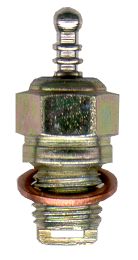Glow Plug Problems
 Today's glow plugs, whether it be ours or a competitor's, are well made products, and they should give you good service. Although the life of a glow plug is unpredictable, you should reasonably expect a dozen or more flights out of one. If you have a motor which seems to eat glow plugs, the probability is that it is suffering from one of the following three causes:
Today's glow plugs, whether it be ours or a competitor's, are well made products, and they should give you good service. Although the life of a glow plug is unpredictable, you should reasonably expect a dozen or more flights out of one. If you have a motor which seems to eat glow plugs, the probability is that it is suffering from one of the following three causes:
Overheating — A glow plug coil will melt if it gets too hot. Reasons why this happens vary. Sometimes the combination of running a motor wide open with a lean setting before you take the glow plug heater off is too much for the element. Quite often people use a power panel which has a built-in surge characteristic, which results in momentary over-voltage when the plug is first switched on. When a glow plug fails due to overheating, the end of the element wire has a tear drop shape. Unless you have very unusual eyes, you cannot detect this without the aid of a microscope or magnfying glass. We use a 20 power microscope which brings it up where you can plainly see the end of the break.
Vibration — If the engine is not rigidly mounted and can move around very much, the element is shaken from side to side with tremendous "G" forces. This literally fatigues the metal until it breaks. When you look at the end of the element wire break through a microscope it has a jagged, rough type appearance. The only solution is to increase the rigidity of your engine mount.
Shock Wave — Most model engines use a steel or brass liner mounted on top of a cast aluminum case. As the engine gets older, the liner flange works its way down into the case and lowers the head with it. When the piston clearance gets down to about .010, air is forced out of the squish band area with supersonic velocity and the action on the glow plug element is like when a jet plane zooms over your house and knocks out the windows. The cure here is to raise the head with another head gasket.
Less often, reasons why glow plugs sometimes fail are:
Cranking the engine when it is flooded. This sprays raw fuel onto the plug and the droplets beat the element over to the side of the housing where it shorts out.
Another problem that occasionally occurs is that motors sometime take to wearing abnormally, such as a cracked cranshaft chewing metal out of the bearing, or a connecting rod that is chewing metal. Of course, when this metal goes up and deposits on the plug element, the plug burns out.
